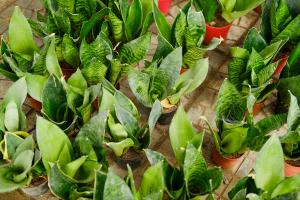What is Eating My Money Tree Plant?
Money tree plants are popular houseplants due to their ease of care and unique appearance. However, they can still fall victim to pests and diseases that can affect their health and cause damage. One common issue that money tree plant owners may face is pests that feed on the plant’s leaves and stems, ultimately leading to stunted growth or death if left unchecked. In this article, we’ll explore some of the most common culprits that may be eating your money tree plant and how to identify and treat them.
Thrips
Thrips are tiny, slender insects that can wreak havoc on money tree plants. They pierce the plant tissue with their sharp mouthparts, causing damage and discoloration on the leaves. Symptoms of a thrip infestation include silvery streaks on the leaves, black fecal matter on the undersides of the leaves, and curled leaves. To get rid of thrips, you can try spraying the plant with neem oil or insecticidal soap. It may take a few treatments to fully eradicate these pests.
Spider Mites
Spider mites are another common pest that can cause problems for money tree plants. While they are difficult to spot with the naked eye, their presence can be seen in damage to the foliage. Signs of a spider mite infestation include yellowed and stippled leaves, webbing on the plant, and small, dark specks on the leaves. To treat spider mites, you can spray the plant with a solution of 1 part rubbing alcohol to 3 parts water or an insecticidal soap spray. Be sure to follow the instructions carefully to avoid damaging the plant.
Mealybugs
Mealybugs are small, soft-bodied insects that often congregate on the undersides of leaves and along the stems of money tree plants. They suck the sap from the plant, causing it to weaken and become more susceptible to disease. Signs of a mealybug infestation include a sticky residue on the plant, yellowed and wilted leaves, and fluffy white egg sacs on the undersides of the leaves. To control mealybugs, you can use a cotton swab dipped in rubbing alcohol to manually remove them or use an insecticidal soap spray.
Scale Insects
Scale insects are another common pest that frequent money tree plants. They have a hard, shell-like outer covering that protects them from predators and pesticides, making them difficult to control. Signs of a scale infestation include yellowed and sticky leaves, and tiny bumps or scales on the plant’s stems and leaves. To treat scale insects, you can try scraping them off the plant manually with a soft-bristled brush or applying an insecticidal soap spray. Repeated treatments may be necessary to fully eliminate the pests.
Preventing Pest Infestations
While it’s essential to control pests that may be eating your money tree plant, prevention is always the best course of action. Here are a few tips for keeping your money tree plant healthy and pest-free:
Inspect your money tree plant regularly for signs of pests or diseases.
Keep the plant in a bright, well-ventilated area with consistent temperatures and humidity levels.
Water the plant only when the top inch of soil is dry to the touch.
Avoid over-fertilizing or using the wrong type of fertilizer on your money tree plant.
Use clean pots and soil when repotting your money tree plant to prevent introducing pests or diseases.
By taking these steps and monitoring your money tree plant closely, you can help ensure its health and prevent pest infestations from taking hold.
Conclusion
If you notice something eating your money tree plant or causing damage to its foliage, identifying the culprit is essential. Whether it’s thrips, spider mites, mealybugs or scale insects, there are treatments available to control these pests and keep your plant healthy. However, taking preventative measures such as regular inspections and proper care can provide the best defense against pest infestations.

 how many times do yo...
how many times do yo... how many planted tre...
how many planted tre... how many pine trees ...
how many pine trees ... how many pecan trees...
how many pecan trees... how many plants comp...
how many plants comp... how many plants can ...
how many plants can ... how many plants and ...
how many plants and ... how many pepper plan...
how many pepper plan...





























